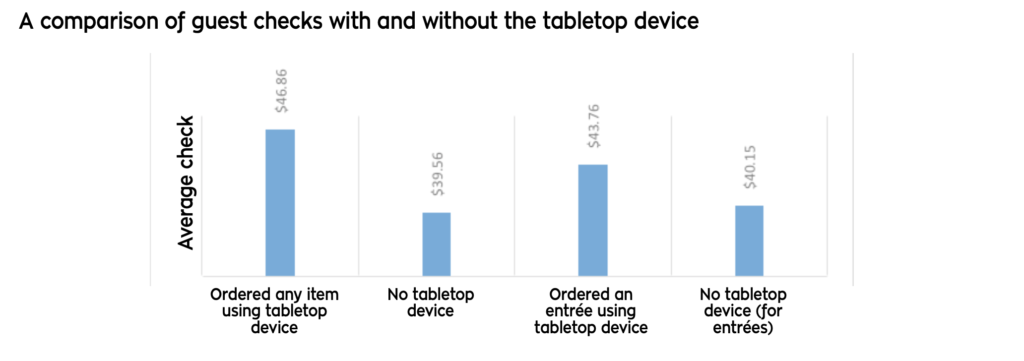Mobile POS is providing servers and front-of-house staff with mobile devices capable of running your POS, freeing them from non-productive tasks to do the high-impact work that drives revenue for your business.
We’ve written before about the benefits of a mobile POS solution when it comes to extending your service to patios and outdoor dining areas. The capabilities don’t end there. Mobility can free your servers on the floor to do the high-impact work that leads to an amazing guest experience while significantly increasing revenue.
The Benefits of Mobile POS by the Numbers
Higher Checks & Covers, Faster Table Turns, Lower Operational Costs
Workflow Efficiency
Servers who are back and forth from their section to a fixed terminal constantly disappear: to pass along orders, check on ingredients or dish prep with the kitchen, run a credit card, or switch a drink order with the bar. These pockets of vanishing service—multiplied many times by the number of tables in every server’s section—do more than slow responsiveness. These service’ dead spots’ both cost money via operational costs and impact the quality of the guest experience. Instead of trimming costs by reducing portion sizes, raising prices, or limiting staff, operators can employ a different tactic. Increase efficiency.
A Cornell study found that guests who order at the table require up to 30% less server time without impacting the guest experience. Imagine if you had 30% more front-of-house staff without a commiserate increase in cost. That’s what mobile POS can bring to your operation. Add the benefits of table-side payment and that number can reach as high as 60%.

Table Turns and Section Size
With mobile POS, servers are on the floor more. They can be present at their tables, which means guests are receiving more attentive service, and the flow of guests is more optimal.
In truth, when servers can take both orders and payments at the table, the study found a remarkable reduction in the average meal duration.

As you can see, the adoption of mobile POS reduced the average meal duration from 1:02:58 to 42:04, or nearly 35%. Such a significant impact is especially valuable in full-service environments. An increase in table turns of that magnitude can result in another seating or the extension of the most profitable times for the business when demand for tables is greater than the supply.
Increased Check Size (And Guest Satisfaction!)
It just makes sense that when servers are more present to do the kind of work that helps guests make decisions – explaining features and specials, recommending pairings, highlighting popular items – that check sizes increase.
For servers, mobile POS reduces the number of steps required to do their job, allowing that extra effort to be applied to the more important elements of guest service, such as upselling, increased attentiveness and care to each table, and cross-training to improve servers’ abilities.
For guests, they have more control over the dining experience. The awareness that the server is present and attentive converts to guests being more comfortable and more likely to impulse order – another round, dessert, or the same delicious appetizer they see on the table next door.
The research shows that’s precisely what happens.

In the study, checks rose from an average of $39.56 prior to the adoption of mobility to $46.86, a 16% increase in revenue, with zero additional cost to the operation and an improved guest experience.
How to Proceed
The benefits of mobile POS aren’t restricted to an operations scale. Any full-service restaurant can immediately take advantage of mobility. It does make sense to consider some elements first:
- Workflow Changes. When servers first hold a tablet for table-side ordering, they’ll recognize the same interface they’re used to, but in their hands. So training is minimal from that viewpoint, but workflows will probably change.
- A Trial Run. Mobility isn’t an all-or-nothing proposition. We’ve seen many customers implement mobile POS first to satisfy guests on patios, then bring the capability inside to the dining room floor.
- Complimentary Technologies. Mobile POS doesn’t have any technical requirements of its own beyond network connectivity (aside from being supported by your POS!), but the benefits are best realized when mobility is a component of a larger strategy. The most effective mobility strategy includes contactless devices allowing guests to pay at the table.
We hope this article has helped illustrate how mobile POS can bring real and substantial benefits to hospitality. If you’d like to learn more about how Squirrel is helping our customers succeed with this capability. Watch this webinar on the topic, recorded Thursday, May 6th.




